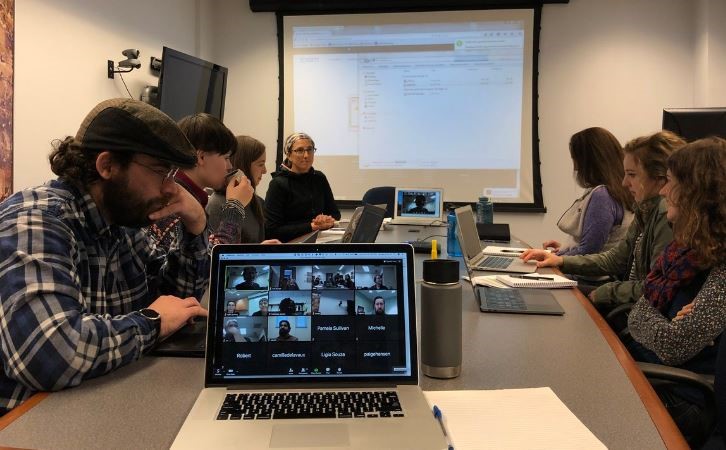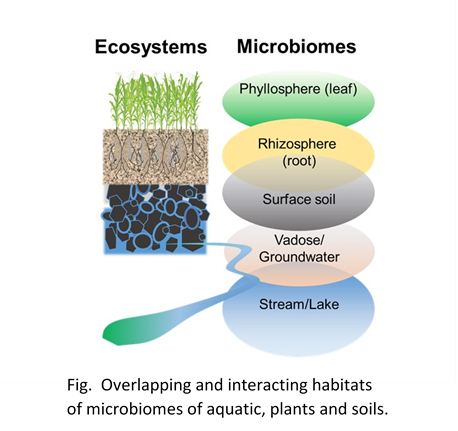
View of the collaborative class from a KU conference room (A. Burgin)

Figure by J. Bever
In 2018, the Kansas NSF EPSCoR RII Track-1 Award OIA-1656006: Microbiomes of Aquatic, Plant and Soil Systems across Kansas (MAPS) researchers developed a ZOOM conferencing collaborative biology course for undergraduate and graduate students. Every Tuesday and Thursday, students and professors from the University of Kansas (KU), Kansas State University (KSU), Wichita State University (WSU), and Fort Hays State University (FHSU) met in a common area on their campus to video conference. The goal of the class was to learn more about the MAPS students’ and faculty’s research projects and to review the existing literature on linkages between and feedbacks among plant, soil, and freshwater microbiomes. Each faculty member of the Kansas NSF EPSCoR MAPS research team presented their research and assigned key papers to achieve this goal. Then the lead instructors Drs. Walter Dodds, from KSU, and Jim Bever, from KU, facilitated in-depth discussions to analyze what was presented.
Synthesizing what they learned from participating in the class, the instructors and students laid out a conceptual framework describing the functions of, and interconnections between, the terrestrial and aquatic microbiomes. Bever and Dodds explained the model as follows, “The dynamics of freshwater aquatic systems are heavily influenced by P and N concentrations, and variation in inputs of these nutrients to aquatic systems has potential consequences for aquatic microbiomes and their associated ecosystem services. The model is based on the idea that mycorrhizae-mediated P retention will decrease movement of P to the aquatic environment, and that species interactions within the aquatic environment may exacerbate or mitigate this effect on harmful algal blooms.” At the conclusion of the course, students and faculty wrote a collaborative paper discussing their conceptual model and submitted it for publication. The article is titled Connections and Feedback: Aquatic, Plant, and Soil Microbiomes in Heterogeneous and Changing Environments and was recently published in the Oxford Academic American Institute of Biological Sciences BioScience journal volume 70, issue 7, July 2020, pages 548–562. The authors of the article are Dr. Walter K. Dodds (KSU), Dr. Lydia H. Zeglin (KSU), Robert J. Ramos (KU), Dr. Thomas G. Platt (KSU), Aakash Pandey (KSU), Theo Michaels (KU), Dr. Mohammadali Masigol (KSU), Anna M. L. Klompen (KU), Michelle C. Kelly (KU), Dr. Ari Jumpponen (KSU), Emma Hauser ,(KU), Paige M. Hansen (KU), Dr. Mitchell J. Greer (FHSU), Niloufar Fattahi (KSU), Camille S. Delavaux (KU), R. Kent Connel (KSU), Dr. Sharon Billings (KU), Dr. James D. Bever (KU), Niloy Barua (KSU), and Dr. Folashade B. Agusto (KU).
In describing the significance of the model, Bever and Dodds added, “The model was a particularly important accomplishment not just because it was published in a high-profile journal, but more importantly it refined our conceptual model and built a common understanding of our MAPS research mission and strength. This model will be used to synthesize MAPS field data via structural equation modeling in the coming years.”
To access the abstract and learn more, click here. (Members of the American Institute of Biological Sciences can access the article in its entirety at this link as well).
Another new collaborative multi-University course will be offered in the Fall of 2020. Dr. Ben Sikes will lead the expansion of an existing KU Course (BIOL701: Structural Equation Modeling for Biologists) offering it to the four major Kansas Regents Universities (KU, KSU, WSU, and FHSU) that participate in MAPS research. The course already has 14 students planning to enroll, from three different Universities. It will be offered as a flexible virtual course, patterned after the successful 2018 MAPS Microbiomes.
